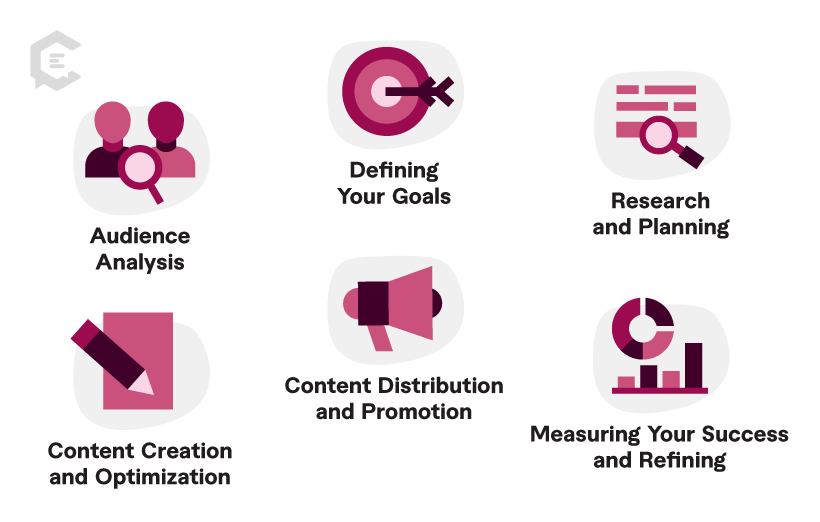What is a content strategy?
A content strategy is the holistic plan you use and consult when including content creation as part of your overall marketing strategy. It’s not simply a calendar of what content you’re creating; it’s also about which content you’ll create, how you’ll create it, when you’ll create it, and why you’re creating it.
(And no, “going viral” is not a content strategy.)
What goals do you hope to achieve with your content? Who are you trying to reach with your content, and on which platforms? How much content will you create in-house, and how much will you outsource?
These are all questions to consider when putting together your content strategy.

Why is it important to have a content strategy?
Failing to plan is planning to fail. If you’re creating content without a strategy in place, you’ll be hard-pressed to justify your content marketing budget to the keepers of the purse strings. Yes, content marketing is a crucial component of your marketing strategy; however, unless you know WHY you’re creating content and for whom (at the very least), you won’t see any returns on your content investment.
But if you don’t currently have a content strategy in place, don’t panic – you’re not alone! Less than 60 percent of marketers who utilize content marketing claim to have a content strategy in place, and there’s no time like the present to get started.
Your content strategy will not only answer all the questions you have about your content creation, but it will also align your team, workflow, and systems for a streamlined output.
How do you create a content strategy?
Content strategy is one of the things we do best, so we’ve put together a printable workbook, and you can also follow along with these steps:
- Know your audience. Who are you marketing to? And what drives them to take action?
- Define your goals for your content. What do you hope your content will accomplish? Brand awareness? Lead generation? These answers will inform what content you create.
- Conduct research and plan. Examine any existing content and conduct keyword research. Ideate content topics and prioritize them.
- Create and optimize your content. Ensure each piece aligns with your goals and audience preferences while optimizing for search engines and user engagement.
- Distribute and promote your content. Hitting “Publish” isn’t the last step. How will you reach your audience with your content?
- Measure your results and adjust accordingly. Use pre-determined metrics to evaluate how successful your content is and what needs improving.

Key Components of an Effective Strategy
Let’s break it down by step! (And if you’re really advanced, you’ll apply all of these to a content strategy aligned with the buyer’s journey.)
Audience analysis. You should know your audience’s
- Demographics (age, gender, occupation, location, etc.)
- Psychographics (values, opinions, attitudes, interests, etc.)
Defining your goals. Typically, content strategy goals are focused in one of four areas:
- Brand awareness
- Thought leadership
- Lead generation
- Engagement and loyalty
But in general, your goals should always be specific, measurable, achievable, relevant, and time-bound (SMART).
Research and planning. Developing your content roadmap consists of five steps:
- Conduct content research
- Create a keyword and topic portfolio
- Topic ideation and prioritization
- Develop taxonomies (create a classification system for your content topics)
- Write content briefs
Content creation and optimization. Your content should not only be high-quality but also optimized for user experience and SEO. When creating content, ask these questions:
- Is it providing value?
- Is it engaging and well-structured?
- Is it clear and actionable?
- Is it proofread and polished?
- Is it upfront and honest?
- Does it align with your business goals?
- Does it have a strong and seamless user experience?
- Is it optimized for SEO? (including keywords, readability, and sentence length)
Content distribution and promotion. Your audience research will let you know where your audience hangs out online, so make sure you’re set up to reach them in those places. Consider creating a separate content distribution plan.
Measuring your success and refining. Now that you’ve published your content, it’s time to find out what worked and what didn’t. Based on what you’ve determined to be the goals of your content, you’ll likely want to review some (if not all) of these data points:
- Conversion rate
- Website traffic
- Click-through rate
- Bounce rate
- Churn rate
- Time on page
- Page views
- Unique visitors

Content is Best When You Collaborate
You’ve come to exactly the right place. When you work with ClearVoice as your managed content solution, you can trust that your content – and content strategy – are in good hands. We’ll discuss your goals for your content and come up with a content plan that meets your needs and your resources so that you’ll never pay for content that you don’t need or won’t use. Talk with a content specialist today, and let us strategize your content for you!



